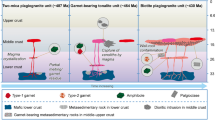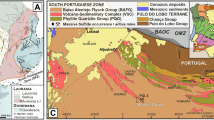Summary
The Fanos granite, a Jurassic pluton composed of high silica fine- to coarse-grained leucogranites, is associated with and intrudes the Mesozoic Guevgueli ophiolitic complex. Discriminant diagrams indicate a collision related plate tectonic environment for the rocks studied. They are peraluminous with calc-alkaline affinities. Major and trace element behaviour suggest a fractional crystallization process for the evolution of the Fanos granite. Petrographic calculations, based on major elements, require 32% crystal accumulation mainly of plagioclase, K-feldspar and biotite for a direct model, while for a two-step model 21% and 14% crystal cumulate is required for the first and the second step respectively.
Zusammenfassung
Der jurassische Fanos-Granit ist ein fein- bis grobkörniger Leukogranit mit hohem Silikatanteil. Er ist mit dem mesozoischen Ophiolithkomplex von Guevgueli, mit dem er in instrusivem Kontakt steht, verknüpft.
Diskriminierungsdiagramme weisen darauf hin, dab die untersuchten Gesteine im Zuge kollisions-tektonischer Prozesse gebildet wurden. Die untersuchten peraluminösen Gesteine folgen einem kalkalkalischen Trend. Die Haupt- und Spurenelementverteilungen belegen eine fraktionierte Kristallisation des Fanos-Granites. Einfache Mischungsmodell-Berechnungen, die mittels der Hauptelemente erstellt wurden, ergeben eine 32 %ige Kristallakkumulation von vorwiegend Plagioklas, Kalifeldspat und Biotit. Eine Zweistufenmodell-Berechnung ergab eine 21- beziehungsweise 14 %ige Kristallakkumulation für die erste und zweite Stufe.
Similar content being viewed by others
References
Anderson JL, Cullers RL, Van Schmus WR (1980) Anorogenic metaluminous and peraluminous granite plutonism in the Mid-Proterozoic of Wisconsin, USA. Contrib Mineral Petrol 74: 311–328
Andronopoulos B (1965) The geology and mineralization of the Axioupolis area (Central Macedonia). Geol Geoph Res IGSR Athens, (in greek with english abstract) 9: 145–173
Bebien J (1977) Mafic and ultramafic rocks associated with granites in the Vardar zone. Nature 270: 232–234
—— (1981) A propos de 1' association de certaines formations ignées basiques á caractéres ophiolitiques avec des granites et des migmatites. C R Acad Sci Paris 292-II: 733–735
— (1982) L' association ingée de Guevgueli (Macédoine Greque), expression d'un magmatisme ophiolitique dans une dechirure continentale. Thése d' Etat, Nancy (unpubl): 470 pp
——Ohnenstetter D, Ohnenstetter M, Vergely P (1980) Diversity of the Greek ophiolites: Birth of oceanic basins in transcurrent systems. Ofioliti (Spec Iss Tethyan Ophiolites) 2: 129–197
Borsi S, Ferrara G, Mercier J, Tongiori E (1966) Age stratigraphique et radiometrique Jurassique supérieur d'un granite des zones internes des Hellénides (granite de Fanos, Macédoine, Grèce). Rev Geog Phys Geol Dyn 8: 279–287
Chappell BW, White AJR (1974) Two contrasting granite types. Pacific Geol 8: 173–174
Christofides G, Soldatos T, Koroneos A (1989) Geochemistry, evolution and origin of the Fanos granite (Northern Greece). Fifth meeting of the European Union of Geosciences (EUG). Terra Abstracts 1: 282
Cocherie A (1986) Systematic use of trace element distribution patterns in log-log diagrams for plutonic suites. Geochim Cosmochim Acta 50: 2517–2522
Deer WA, Howie RA, Zussman J (1978) An introduction to the rock-forming minerals. Longman, London, 528 pp
Hanson GN (1978) The application of trace elements to the petrogenesis of igneous rocks of granitic composition. Earth Planet Sci Lett 38: 26–43
Harris NBW, Pearce JA, Tindle AG (1986) Geochemical characteristics of collision-zone magmatism. In:Coward MP, Ries AC (eds) Collision tectonics. Geol Soc Spec Publ No 19. Blackwell Scientific Publications, Oxford, pp 67–81
IUGS (1973) Classification and nomenclature of plutonic rocks. N Jb Miner Mh 4: 149–164
Karamata S, Majer V, Pamic J (1980) Ophiolites of Yugoslavia. Ofioliti (Spec Iss Tethyan Ophiolites) 1: 105–125
Le Maitre RW (1981) GENMIX-A generalized petrological mixing model program. Computers & Geosciences 7: 229–247
Maaløe S (1985) Principles of igneous petrology. Springer, Berlin Heidelberg New York, 374 pp
Marakis G (1969) Geochronology studies of some granites from Macedonia. Ann Geol Pays Hell 21: 121–152
McCarthy TS (1976) Chemical interrelationships in a low pressure granulite terrain in Namaqualand, South Africa, and their bearing on granite genesis and the composition of the lower crust. Geochim Cosmochim Acta 40: 1057–1068
Mercier J (1968) Etude geologique des zones internes des Hellénides en Macédonne centrale (Grèce). Contribution á l'étude du metamorphism et de 1' évolution magmatique des zones internes des Hellénides. Ann Geol Pays Hell 20: 1–792
Neiva ANR, NeivaJMC, Parry SJ (1987) Geochemistry of the granitic rocks and their minerals from Serra da Estrela, Central Portugal. Geochim Cosmochim Acta 51: 439–454
Nicolas A, Jackson ED (1972) Repartition en deux provinces des peridotites des chaînes alpines longeant la méditerranée: implications géotectoniques. Schweiz Min Petr Mitt 52: 479–495
Pearce JA, Harris NBW, Tindle AG (1984) Trace element discrimination diagrams for the tectonic interpretation of granitic rocks. J Petrol 25: 956–983
Spray JG, Bebien J, Rex DC, Roddick JC (1984) Age constraints on the igneous and metamorphic evolution of the Hellenic-Dinaric ophiolites. In:Dixon JE, Robertson AHF (eds) The geological evolution of the Eastern Mediterranean. Geol Soc Spec Publ No 17. Blackwell Scientific Publications, Oxford, pp 619–627
Streckeisen A, Le Maitre RW (1979) A chemical approximation to the modal QAPF classification of the igneous rocks. N Jb Miner Abh 136: 169–206
Taylor SR (1965) The application of trace element data to problems in petrology. Phys Chem Earth 6: 133–213
Thorton CP, Tutlle OF (1960) Chemistry of igneous rocks, I. Differentiation Index. Amer J Sci 258: 664–684
Tsamantourides P, Pergamalis F (1977) Geological and metallogenetic map of “Fanos-Piyi” area, Kilkis district. IGME, Athens, unpublished report, (in greek): 29 pp
White AJR, Beams SD, Cramer JJ (1977) Granitoid types and mineralization with special reference to tin. In:Yamada N (ed) Plutonism in relation to volcanism and metamorphism, Int Corr Prog 7th Circum-Pac Plutonism Proj Meet, Toyama, pp 89–100
——Chappell BW (1977) Ultrametamorphism and granitoid genesis. Tectonophysics 43: 7–22
— — (1983) Granitoid types and their distribution in the Lachlan Fold Belt, Southeastern Australia. In:Roddick JA (ed) Circum-Pacific Plutonic Terranes, Geol Soc Am Mem, pp 21–34
Author information
Authors and Affiliations
Additional information
With 6 Figures
Rights and permissions
About this article
Cite this article
Christofides, G., Soldatos, T. & Koroneos, A. Geochemistry and evolution of the fanos granite, N. Greece. Mineralogy and Petrology 43, 49–63 (1990). https://doi.org/10.1007/BF01164221
Received:
Accepted:
Issue Date:
DOI: https://doi.org/10.1007/BF01164221




